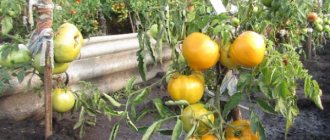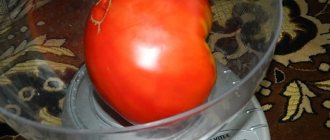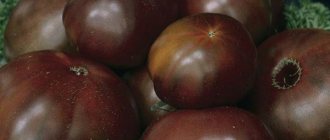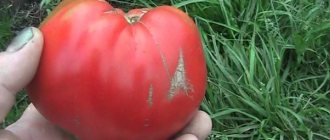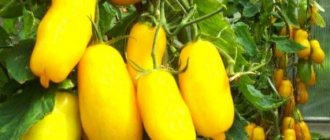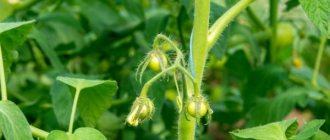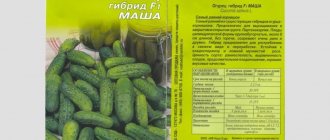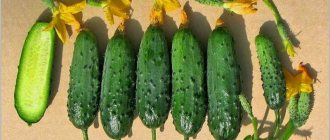The hybrid variety Betta is another representative of stocky trunks. Refers to the earliest and most productive varieties. The creators of the hybrid are Polish breeders. Thanks to the successful crossing of varieties, 5-6 juicy and sweet tomatoes ripen on each bunch. They are very easy to care for, so they are ideal for beginner gardeners.
Due to the high content of lycopene, the fruits have a rich red hue and are excellent for dietary nutrition. Antioxidants reduce the risk of developing some forms of other cancers, cardiovascular diseases, improve metabolism and appetite, slow down the aging process, and help produce melanin in the skin, which fights the effects of UV rays.
Description
Betta tomatoes are an ultra-early hybrid variety of tomatoes for growing in open ground, less often in a greenhouse. A standard low-growing plant up to 50 cm high with a powerful stem device. Refers to potted crops that bear fruit well on balconies or window sills and ripen together.
Distinctive features
The dwarf variety is suitable for cultivation on a windowsill or balcony, in open ground. A completely unpretentious, moderately leafy type, suitable for lazy gardeners who rarely visit the garden.
Fruit characteristics, yield
The pulp is juicy, low in seeds, medium-sized tomatoes up to 60 g, individual fruits up to 100 g. The shape is flat-round, the skin is smooth, does not crack, bright red in color, quite elastic. The taste and aroma are rich, sugar content and acidity are balanced. Productivity up to 2 kg from each bush.
Appearance of tomatoes
The tomatoes of the Betta variety themselves are nothing special: ordinary medium-sized red fruits of a very common flat-round shape. The appearance of the bush is interesting: very stocky, during the fruiting period they resemble a small New Year tree, covered with red toys mixed with not yet fully ripened greenish and brown ones. The fruits cannot be called equal in size: the very first ones are significantly larger than those that ripen by the end of the growing season, which occurs by the middle or end of July.
In appearance, the fruits of the Betta tomato are completely ordinary, reminiscent of almost half of the traditional varieties
Photo
In the photo below you can see what the vegetable looks like:
Disease and pest control
Since Betta tomatoes ripen early, they are not susceptible to late blight, but pathogenic fungi can infect a vegetable plant with another infection:
- Curling of leaves on a vegetable crop occurs due to a physiological disorder of the green organism due to excess moisture, lack of phosphorus in the soil, and excessive dry air. The plant can inherit the disease, so you should not take seeds from diseased tomatoes.
- White leaf spotting can be prevented by spraying Betta bushes with Bordeaux mixture three times with an interval of ten days.
- The appearance of a dark spot of rot on the top of the tomato indicates the development of a fungal disease. Diseased fruits must be removed and destroyed, and healthy bushes should be watered more abundantly.
Description and characteristics of the apple tree variety Yablochny Spas, history and cultivation characteristics
Among the pests that attack vegetable plantings are slugs, mole crickets, and during flowering - aphids and spider mites. All pests are controlled by spraying with insecticides such as Aktara, and slugs and caterpillars are collected by hand. Among the folk remedies, treating tomatoes with a decoction of onion peels will help eliminate parasites. It is prepared by infusing twenty grams of husk in one liter of water. The bushes are sprayed three times at intervals of ten days.
If tomatoes are damaged by wireworms, then it is necessary to feed the plantings with potassium salt in a timely manner. And for the larvae of the click beetle, it is best to spread bait made of cut potatoes poisoned with insecticides.
When the rules of agricultural technology for caring for tomatoes are followed, then the plant is not attacked by pests.
How to get seedlings?
Growing on a windowsill requires a supply of all necessary materials such as:
- high-quality seeds with an unexpired shelf life;
- pre-prepared soil mixture;
- complex fertilizers;
- growth stabilizers;
- small and larger containers;
- sprayer for processing seedlings;
- manganese and other antiseptics.
Seeds are sown in the first ten days of April, and seedlings are transferred to the beds 1 month after germination. As a rule, shoots appear within a week.
Seed preparation
Seed preparation includes standard procedures such as antiseptic treatment with potassium permanganate (1%) or another solution.
- To prepare a manganese solution you will need 200 ml of water and 2 g of pharmaceutical manganese in crystals.
- Next, the seeds are generously washed with clean water and allowed to rest and dry for half an hour.
- A hormonal-based growth stimulator will help speed up the process of crop ripening by another 4-5 days. It happens that manufacturers themselves treat them with stimulants, then the seeds have bright colors and do not need additional nutrition.
- After all this, they are thoroughly dried again and put away completely (for a day) in a container with warm, non-chlorinated water until they swell.
Important! To prevent the seeds from floating and drying out, they are also covered with a cloth or wrapped in a gauze bag. On the second day you can already plant, although some wait another day or two until the sprouts appear.
Container and soil
Betta tomatoes love loose and fertile soil. The soil should be heavy and loamy. Wood ash, mineral fertilizers, 1/2 part of sand per 10 kg of soil are added in advance and, if desired, non-acidic peat (ph 6.5) can be added.
The plants are not picky about the composition of the soil; the seedlings easily adapt and do not require special care. The container can be shared or individual for each seed (a glass up to 100 ml), shallow, up to 15 cm high.
After two weeks, the first true leaves appear, which means it’s time to pluck and transplant the seedlings into larger containers. At the same time, they can be additionally fed with complex fertilizer.
Sowing
- There is no need to deepen the seeds (1 cm is enough), but make sure that they do not come to the surface during the process. To do this, the soil above the seed is quietly compacted.
- The distance between the seeds is 2 cm.
- The container is covered with polyethylene and left at a temperature of 20-25 C for several (up to 5) days. The main thing is to ensure that the seeds do not ferment, pay close attention to the humidity.
What kind of care is needed?
Water with moderately purified and warm water; there must be drain holes at the bottom to allow excess moisture to drain away and air to circulate well. The seedlings are strong and almost always take root well.
After the shoots emerge, the film is removed, the temperature is lowered to 16 C. And after a week, the Betta hybrid will also have to be illuminated for 16 hours in March and April. It is recommended to carry out hardening two weeks in advance, although it is not necessary for the Betta variety. To do this, the seedlings are taken out into the open air, first for a couple of hours, then more, and finally they can be left overnight.
Transplanting tomatoes into open ground
30-day-old seedlings are suitable for planting Betta tomatoes in the ground.
30-day-old seedlings are suitable for transplanting into the ground . Two weeks before transplanting, you need to harden off the seedlings. You can take it outside during the day (to a greenhouse or hotbed) and bring it home at night.
Transplantation into the ground is carried out at the end of May - beginning of June . You can't name a specific date. Each region has its own climate, which determines the timing of transplantation. Forecasters should not worry about frosts on the soil, and the soil itself should be warmed to 15-18°C.
The bushes are small, so there is no need to put stakes. Up to 6 roots can be placed per 1 m2. More frequent (rare) plantings are not recommended.
How to grow tomatoes?
In late May - early June, seedlings are transferred to the ground. At this point, the tomatoes are about a month old from the moment the seeds germinate. The main condition is that the soil must be warmed up during the day and at night to at least 15 C. The best time for replanting is early morning or evening, the weather is better damp. Choose the sunniest place on the site.
Landing
Planting of seedlings occurs at the beginning of May, when the age of the plant reaches 30-35 days. In open ground, a bush density of 50x30 cm is allowed.
- They are not planted very deep because the roots are quite short.
- Ash and complex fertilizers are added to the holes as an antiseptic.
- Water generously with warm, settled water.
- The roots and soil also need to be squeezed thoroughly with your hands.
Care
Always water at the root, so as not to provoke flying of inflorescences and disease. In dry weather, the amount and frequency of watering is increased; in wet weather, on the contrary, during flowering it is also reduced.
Thanks to the low and strong trunk, they do not require staking or pinching. Lack of water affects the leaves as they fall and turn yellow. Excess, on the contrary, promotes fungal diseases and rotting of the root system.
In general, care is the simplest:
- watering once every 5-7 days;
- fertilizer 3 times per season;
- loosening;
- manual weeding.
Mulching also promotes better moisture and ventilation of the root system. It is recommended to mulch with organic matter (dry grass, shavings, husks, sawdust, straw) or inorganic materials (perforated bag). A protective layer of mulch fights pests and weeds, prevents overheating and compaction.
Due to the high density of beds, the Betta variety is less prone to weed growth. Weeding is always carried out in the early stages of weed development, so as not to accidentally damage the crop itself. The best prevention is the right choice of mulch, which will prevent weeds from pollinating. Proper compost, which should not contain freshly picked weeds, also helps.
It responds well to additional fertilization. For example, you can take 30 g of superphosphate or potassium salt per bucket of water and water it 10-12 days after planting in the ground. To stimulate the ovaries, spray boric acid (10 g) onto a bucket of water.
Features of cultivation and possible difficulties
The agricultural technology of tomatoes does not cause any particular problems, but you can make the growing process more comfortable and easier.
- The method of direct sowing of seeds is more suitable for the southern regions.
- It is not recommended to place it together with other varieties of tomatoes, as this can lead to cross-pollination and possibly reduce yield.
- To protect young plants from cold and wind, temporary shelters are additionally installed.
Diseases and pests
It has genetic immunity to a number of nightshade infections. Extremely rare, but still possible cases of the disease:
- top rot;
- TMV (tobacco mosaic virus);
- Alternaria (dry spotting).
The main threat is the attack of parasites on the tomato beds, such as:
- Colorado potato beetles;
- spider mite;
- thrips.
Preventive measures will help avoid their occurrence:
- weeding;
- hilling;
- manual collection of larvae;
- treatment with safe insecticides.
Caring for the variety after transplantation
The Betta tomato requires simple care:
- Watering.
- Feeding.
- Loosening row spacing.
- Removing weeds.
- Carrying out preventive measures against pests and diseases.
- Treatment of tomato bushes in case of illness.
You need to water the bushes once a week . In case of heat and drought, watering can be slightly increased. The ground under low bushes should be mulched with grass. The grass will prevent contact of ripening fruits with the ground and reduce moisture evaporation.
Betta bushes need to be tied up only if necessary.
There is no need to remove the shoots; there is also no need to tie the bushes to a support. Bad weather does not affect the yield in any way. As summer residents note, Betta harvests are stable from year to year.
Harvesting and application
On average, 85 days pass from the emergence of seedlings to the ripening of fruits. The yield is very good - up to 10 kg/sq. m.
The variety is universal, consumed both fresh and processed. The taste is sweet with moderate sourness.
Excellent for whole-fruit canning and salads; its taste makes it possible to squeeze juices and add to sauces. No less popular as a salad variety. Retains its presentation for a long time, including when transporting over long distances.
Characteristics of tomato
The tomato variety “Betta” was created for cultivation in open ground (OG) in regions with a warm climate. In conditions of moderate temperature, the crop is grown in closed structures. The timing of fruiting does not change due to agricultural technology; the yield meets the criteria stated by the originators. For commercial cultivation in greenhouse conditions, the Betta variety is not profitable. The yield of fruits per 1 m2 is significantly higher for indeterminate varieties.
Productivity and fruiting
In terms of ripening time, the “Betta” tomato variety belongs to the early variety. From the moment the young shoots sprout until the biological ripeness of the fruit, 1.5 months pass. Harvesting begins in the second half of June and lasts until the end of July. The “Betta” tomato forms several flowering clusters, ovaries appear on them simultaneously, and harvesting takes place at intervals of one week. In the last circle, the fruits are smaller and ripen last.
One plant produces an average of 2 kg of tomatoes during the growing season. The standard type is placed in the ground at a minimum distance from each other. If 5 tomatoes are planted per 1 m2, the harvest will be about 10 kg. The Betta variety does not tolerate north winds and lack of sunlight. In a shaded place exposed to drafts, tomato growth slows down, the fruits become smaller, and more acidity appears in the taste. In greenhouse conditions, excess moisture provokes fungal infections.
Area of application of fruits
According to reviews from amateur vegetable growers, “Betta” tomatoes (shown in the photo) are irreplaceable for fresh consumption. Already at the beginning of summer, when other varieties are just beginning to form the first circle of ovaries, the early variety will provide vegetables for salads and freshly squeezed juice. The tomato is unpretentious in transportation, so it is supplied to vegetable stores and markets for sale.
Resistance to diseases and pests
The hybrid tomato variety "Betta" is genetically resistant to a number of infections affecting nightshade crops. Due to early ripening, late blight does not have time to develop. Cases of blossom end rot affecting tomatoes are rare; leaf spotting and curling are more common. In open ground, thrips, spider mites, and Colorado potato beetle larvae pose a threat to the plant.
Advantages and disadvantages of the variety
Determinate varieties are convenient to grow in an open area. They produce less yield than tall crops, but they are also undemanding in terms of care. There is no need to install trellis structures or single supports. Tomatoes do not require pruning or garter. The Betta tomato has a number of advantages:
- early fruit ripening;
- the fruits are small and easy to use;
- the pulp of the Betta tomato is not hard, juicy;
- the fruits ripen at the same time, are well transported, maintaining their presentation.
The disadvantages of the Betta tomato include average resistance to insects parasitizing the crop and the need for preventive measures against bacteria and fungi.
Advantages and disadvantages
Betta tomatoes have a number of advantages due to which they are able to bear fruit so early.
- Almost no full-fledged stepchildren grow up.
- Roots and stems are compact.
- They absorb moisture well from the soil surface; accordingly, all nutrients are used for accelerated formation of ovaries and ripening of fruits.
- Resistant to temperature and humidity changes.
- They are not afraid of late blight due to their super early maturity.
- High yields are achieved through dense planting in a small area.
History of growing the variety
The Betta variety has been known in Russia for more than 20 years. The tomato obtained by Polish breeders was registered in the State Register of Breeding Achievements of the Russian Federation agro in 1997. The variety is recommended for cultivation throughout the Russian Federation in garden plots and small farms. Suitable for cultivation in unprotected soil, greenhouses and greenhouses, as well as at home (on balconies).
Growing Betta tomatoes in a greenhouse is not very profitable due to the short stature of the bushes.
Video: growing Betta tomato
Farmer reviews
This crop is loved by many summer residents. Although the fruits cannot boast of a large mass, thanks to the dense planting of small bushes in the beds, the yield is much higher than many early varieties and is close to high.
Combined with excellent nutritional qualities, unpretentiousness and good presentation, the Betta variety has become a godsend for many farmers.
Igor, 49 years old, Ufa: “Last year I planted seeds of Betta hybrid tomatoes for the first time. The package contained about 30 pieces, treated with a special growth stimulator. Contained substances with disinfecting properties accelerate seed germination by several days.
The plants grew large, more than half a meter high - almost 60 cm, with a stocky stem and a dense arrangement of inflorescences. The tomatoes ripen together and are not large in size. I really liked the homemade canned food from this variety.”
Features of planting and growing Betta tomato
Growing a Betta tomato is very easy. If a very early harvest is not required, it is quite possible to grow it without seedlings by sowing the seeds directly into the garden bed when the weather warms up. Of course, the fruits will ripen only in the second half of summer, but for those who cannot grow seedlings, this option is quite suitable.
Traditionally, Betta is grown through the seedling stage. The peculiarity of the variety is that the seedlings do not need to be at home for more than two months; sometimes they are planted in the garden even 30 days after germination, but it is better to keep them for up to a month and a half in order to have time to harden them well .
Betta tomato seedlings always grow strong
Most articles recommend growing seedlings of this tomato in separate cups. I tried this and that, but didn’t notice a significant difference: Betta tolerates transplanting well from a common box, so there is no point in taking up extra space on the windowsill if the gardener grows seedlings of many varieties of tomatoes and other crops. The seedlings grow very stocky, and by the time they are planted in the ground they are already in full bloom.
The variety is not very cold-resistant; seedlings have to be planted in the garden at the usual time. It was very sad to see when last year suddenly there were serious frosts on June 10–13. When the Siberian variety Velmozha stood almost untouched, the already brown tomatoes began to turn brown on Betta.
This tomato can be planted according to a compacted pattern: even the size of the bush suggests that they can be planted after 30 cm. There are tips to grow a bush with 3-4 stems, but this is not necessary: it will take you longer to figure out where the stepsons are, the time will come harvest. Actually, there is no time to give three standard fertilizers, so it is better to immediately fill the bed with fertilizers, and feed only with ash at the beginning of fruit growth. Watering is carried out according to the usual scheme: until the fruit begins to turn red, 1–2 times a week, then only in case of obvious drought.
By the time the fruits ripen, the Colorado potato beetle may already appear; it will have to be collected manually. One way to keep insects away is by dusting the bed with ash and ground pepper and sowing mustard nearby; marigolds have not yet had time to bloom, but many pests are afraid of the smell of their leaves.
A selection of reviews from amateur gardeners
Most gardeners from temperate and cool climate zones of the Russian Federation grow Betta tomatoes in greenhouses. Gardener-blogger Valery Fedorov (Kirov region) noted its high fertility and early ripeness. The man received a decent harvest from a relatively small garden bed. A gardener with the online nickname Pmozh (Perm region) collected 3 kg per bush in an unheated greenhouse. He did not pick seedlings. The first tomatoes ripened at the end of July.
Igor from the Leningrad region received 2-2.5 kg per plant in his greenhouse. The fruit size is 5-6 cm in diameter. They grew on brushes of 6-8 pieces. The summer resident noted the plant’s increased resistance to late blight. He also advised getting rid of the bushes after harvesting all the ripe tomatoes. The determinate variety does not produce new flowers or ovaries.
Not all gardeners ripened the Betta tomato within the time period specified by the originator. In reviews on thematic forums, people give other numbers. For example, user Galin indicates that the ripening period was 85 days. People have no other complaints about this variety.
Suitable for growing at home
Tomato Betta - photo, description of the variety:
- Betta tomatoes are an early-ripening, determinate, low-growing variety intended for open and closed ground. The ripening period is 80-85 days. Perfect for early harvest at home.
- The bush is small, weakly leafy, with a powerful stem and spreading crown. The height of the plant does not exceed 0.5 m. It does not require pinching, but needs a garter, as it can collapse under the weight of the fruit.
- The tomatoes are round, smooth, with a beautiful gloss, weighing 50-80 g. The color is red, rich. Due to their early ripening, they are not damaged by late blight. The pulp is juicy, sugary on the inside with a pleasant sourness in taste. The seeds are located in 4 seed chambers. The skin is dense and reliably protects the tomatoes during transportation.
- 4-6 fruits are formed on one brush. Ripening is uniform, which allows harvesting with brushes. The yield from one bush is 1.5-2 kg. Due to the compactness of the bushes, Betta is suitable for growing in pots, where it also produces a good harvest.
- The plant does not require care and is suitable for beginner gardeners. The variety is resistant to low temperatures, short-term drought and many nightshade diseases. The characteristic of tomato is the ability to grow the variety in the South using the seedless method, direct sowing into the ground.
Rules for cultivating the Betta variety
The Betta tomato can be propagated using the usual seedling method and direct sowing. In any case, the seeds should be pre-treated:
- check for completeness (when soaked in water, full-fledged seeds will settle to the bottom of the container);
- etch in a 1–2% solution of potassium permanganate or hydrogen peroxide (1 tablespoon of 3% peroxide is added to 0.5 liters of water);
- soak in a growth stimulator (Epin according to instructions, aloe juice in a 1:1 ratio).
Sowing Betta tomato in open ground
This cultivation method is only suitable for warm regions (for example, Crimea or Krasnodar Territory). Considering that seed germination requires a soil temperature of at least 18 ° C (when the temperature drops, seed development freezes), sowing can only be done in early May. You can sow a little earlier, but then to provide the necessary heat you will need to cover the crops with film.
Video: sowing tomato seeds in open ground
Preparing tomato seedlings
In regions with a temperate climate (for example, in central Russia), Betta tomato should be propagated using seedlings. Treated seeds are sown in the first ten days of April. The soil for growing seedlings must be loose and nutritious. You can use a purchased soil mixture or prepare it yourself from equal parts of garden soil, peat and sand.
Sowing order:
- Disinfect the soil (you can simply pour boiling water on it, but it is better to use a hot dark pink solution of potassium permanganate).
- Place the soil in boxes (or other containers) and compact it with your hands.
- Draw furrows (1–1.5 cm deep) in the moist soil using a stick.
- Place the seeds in the furrows and cover with a 1 cm layer of soil. If the soil is not moist enough, spray its surface with warm water from a spray bottle.
- Cover the boxes with polyethylene and put them in a dark room with an air temperature of 22–26 °C.
Tomato seeds are buried 1–1.5 cm in moist soil
After waiting for the sprouts to appear en masse, the film is removed, the boxes with seedlings are transferred to a well-lit windowsill and make sure that the room temperature is kept at 15–16 ° C for 7–8 days. Subsequently, it is raised again to approximately 25 °C.
Young plants need to be watered very carefully so as not to erode the soil around the roots. Watering (with warm water!) is carried out moderately, as the top soil layer dries out
For normal development, sprouts must have sufficient living space, so after a couple of true leaves appear, young tomatoes need to be picked into separate cups.
After two true leaves appear, tomato seedlings are plucked
Transplanting seedlings to a permanent place
Betta tomatoes are transplanted into a greenhouse or open ground at 30 days of age. As a rule, the transplantation period occurs at the end of May - beginning of June, depending on the climate of the region. The main condition is that there is no threat of return frosts. 12–14 days before planting, seedlings should be taken out into the open air during the day for hardening.
The soil must be prepared in advance. Tomatoes of this variety prefer loose, fertile soils, so heavy loams should be enriched in advance with humus (10–12 kg/m2), sand (half a bucket per 1 m2), as well as ash and mineral fertilizers.
Plant seedlings on a cloudy day. The holes should be very moist, since after planting the plants are not watered for 7–10 days. Since Betta bushes do not grow too large, they can be planted quite densely - 5-6 plants per 1 m2.
Planting care
Betta is unpretentious. The size and structure of the bush make gartering and pinching unnecessary. Tomatoes will only need regular watering (every 5-6 days with settled water) and fertilizing with complex fertilizer (3-4 times per season).
The variety is best suited for cultivation in open ground, although it also grows quite successfully in a greenhouse and even produces larger fruits.
Video: growing Betta tomatoes in a greenhouse next to other varieties
My experience in growing Betta tomatoes in a greenhouse has shown that you can get tomatoes that are quite large for this variety, weighing 90–100 g. Each bush bears approximately 10 fruits. I plant them in the greenhouse along with taller and later varieties. Due to the small size of the bushes, the variety can be placed along the aisle. After harvesting the first wave of the crop, I harvest the Betta tomatoes, since by this time the bushes of mid- and late-ripening tomatoes are already growing. I put some of the green Betta fruits remaining on the uprooted bushes for ripening.


